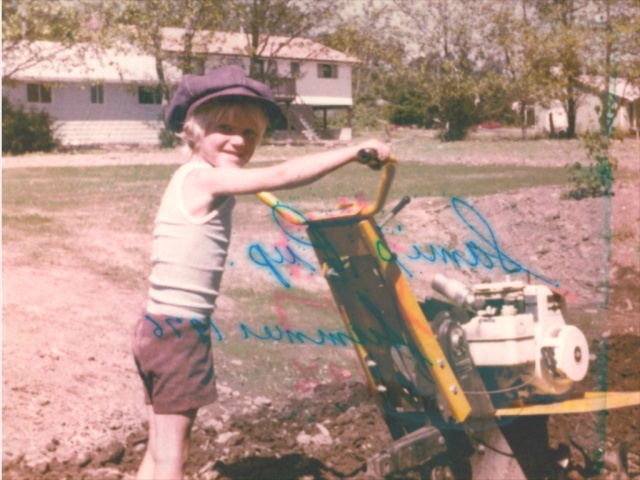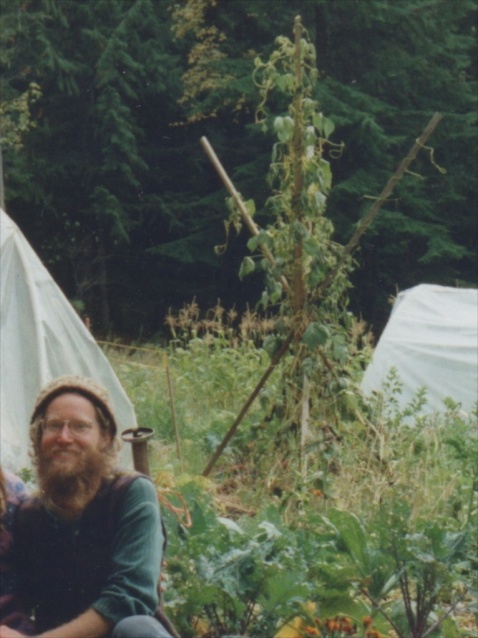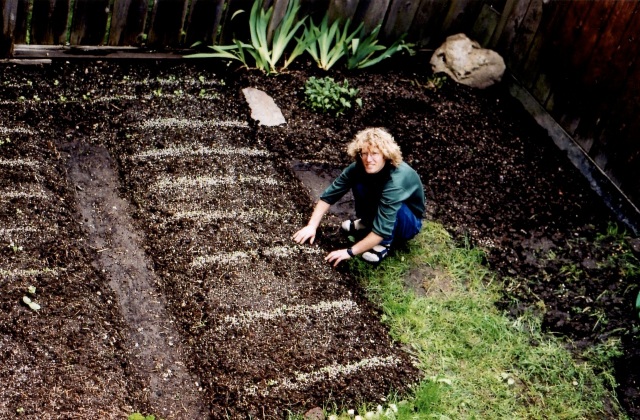With a home-based clinic, a large yard and a love of gardening I am often asked by patients if I grow the medicines that I prescribe for them. Oh how I wish! The reality is, of course, that the amount of herbs I use in a given year is far too large an amount to even consider growing here at home. I simply do not have the space, nor the time, and so I leave this up to the experts – the farmers who make their living by supplying the international herb market. Many of these farmers have long family traditions of growing, or wild crafting, herbal medicines and have thus learned a few tricks along the way, including important information about the proper harvesting and drying of these precious medicines.
Dr. Erikson’s garden at the Windsong Cohousing community, 2010 (before moving to his present location in White Rock).
I myself do have a long history with gardening, first inspired by my grandparent’s (on both sides) garden, which was often full of veggies, fruit and nuts. My parents also kept a garden of some sort while I was growing up, usually a combination of veggies and landscape ornamentals (my mother loves flowers). That young handsome boy in the picture there, tilling the Earth in prep for seeds to be planted, is me at age 5.
When I first studied western herbal medicines in 1991, I was so inspired by my teacher, Dr. Terri Willard’s, stories of living in tents and teepees in the interior of B.C., whilst wildcrafting herbal medicines, that I soon found myself doing the same. By the time my daughter was born in 1995, I was growing most of my family’s food whilst living in various earthen structures (including a teepee and log cabin) in the small village of Argenta at the North end of Kootenay lake. I was also harvesting what ever wild herb I could get my hands on, having a kitchen full of mason jars full of dried specimens.
Below is a picture of a very hairy Dr. Erikson in front of his garden in Argenta, 1996.
When I made the decision to study Chinese medicine and moved back down to Vancouver (leaving Natural paradise in search of deeper Doctoring skills), I quickly became involved in various gardening projects around the city, including the famous Strathcona community gardens near China town. I eventually started my own landscape company, using only hand tools and organic methods, to help pay the way through those initial 5 years of my Doctor of Chinese medicine training. I had huge dreams of growing the medicines I would prescribe to my patients, as it was something that seemed so natural for me to do. But once I started practicing Chinese herbal medicine, becoming busy with many patients, I soon realized that my romantic ideas of supplying my own clinic with herbs that I had grown and collected myself was not going to happen. I simply use too many herbs, and the time and space to grow them was just too big.
Dr. Trevor Erikson planting one of the veggie gardens he kept while being a student of Chinese medicine
Of course this doesn’t mean that I will not grow many herbs for my own family usage or even just for show, as many Chinese herbal medicines are actually very beautiful plants to have on the landscape. Herbs such as red and white peonies (Bai and Chi Shao Yao), forsythia (Lian Qiao), honeysuckle (Jin Yin Hua), trumpet flower (Ling Xiao Hua), rugosa rose (mei gui hua) and celosia flower (Ji Guan Hua) are herbs that I prescribe all the time, that also look fantastic in the garden. So I do plan to grow these ones, including many others. (For anyone interested, Richters seeds in Ontario carry both seeds and plants for many Chinese herbal medicines.) My dream is to make the garden both beautiful and functional, being loaded with edibles, medicinals and fragrant flowers to pick for the dinning room table.
I will also likely follow in my mentor Mazin Al-Khafaji‘s footsteps, as he does grow a few things at his clinic to treat patients. One of the herbs he grows is Chinese impatiens (Feng Xian Hua), as these flowers are a fantastic remedy for nail fungus and is best used fresh (basically ground up fresh and then painted onto the nails), thus the dried plant would not do. Another herb that Mazin is growing in his garden is Bai Ji (Rhizoma Bletillae Striatae), which is now an endangered species due to over harvest in the wild. When used in creams to help with the repair of dry, damaged and cracked hands (a wonderfully effective remedy), only a small amount is needed, thus it is a good one to grow for both practical and conservational purposes.
Out of concern for safety, high quality herbal medicines that are grown without pesticides (and other junk) is becoming quite popular. Spring Wind herbs from California is dedicated to providing herbs that are tested to be free of over 300 different pesticide and other contaminants. They encourage and support farmers to grow certified organic herbal medicines, thus helping to raise the bar in regards to quality and safety. With Chinese medicine representing the second largest medical system in the world, the demand for herbal medicine is forever growing. North American farms are thus sprouting up that are dedicated to providing locally grown Chinese herbal medicines including, for example, High Falls Gardens in New York state.
The coolest thing that I love about Chinese herbal medicine is that the whole practice revolves around nature – Earth, farmer, doctor, patient. Now with so many great herbal growing projects going on in the world that seem trustworthy I can relax my tendency to do everything myself, to be the Doctor growing all his patient’s medicines, and focus on the simpler aspects of gardening, raising my family and practicing Chinese herbal medicine.
Dr. Trevor Erikson




